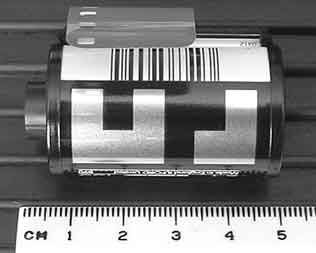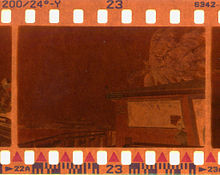
A single-lens reflex camera (SLR) is a camera that typically uses a mirror and prism system that permits the photographer to view through the lens and see exactly what will be captured. With twin lens reflex and rangefinder cameras, the viewed image could be significantly different from the final image. When the shutter button is pressed on most SLRs, the mirror flips out of the light path, allowing light to pass through to the light receptor and the image to be captured.

135 film, more popularly referred to as 35 mm film or 35 mm, is a format of photographic film used for still photography. It is a film with a film gauge of 35 mm (1.4 in) loaded into a standardized type of magazine – also referred to as a cassette or cartridge – for use in 135 film cameras. The engineering standard for this film is controlled by ISO 1007 titled '135-size film and magazine'.
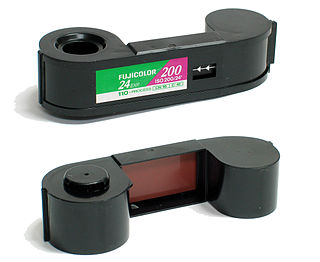
110 is a cartridge-based film format used in still photography. It was introduced by Kodak in 1972. 110 is essentially a miniaturized version of Kodak's earlier 126 film format. Each frame is 13 mm × 17 mm, with one registration hole. Cartridges with 12, 20, or 24 frames are available on-line. Production variations sometimes have allowed for an additional image.

Advanced Photo System (APS) is a discontinued film format for still photography first produced in 1996. It was marketed by Eastman Kodak under the brand name Advantix, by FujiFilm under the name Nexia, by Agfa under the name Futura and by Konica as Centuria.

The DX number was assigned by the International Imaging Industry Association (I3A). It uniquely identifies the type and manufacturer (sensitizer) of a film emulsion. A proprietary list of DX numbers for APS and 135 film was prepared yearly or as needed.. The list was available for sale from the I3A.
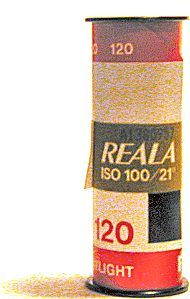
Roll film or rollfilm is any type of spool-wound photographic film protected from white light exposure by a paper backing. The term originated in contrast to sheet film. Confusingly, roll film was originally often referred to as "cartridge" film because of its resemblance to a shotgun cartridge.

An instant camera is a camera which uses self-developing film to create a chemically developed print shortly after taking the picture. Polaroid Corporation pioneered consumer-friendly instant cameras and film, and were followed by various other manufacturers.

Minolta Co., Ltd. was a Japanese manufacturer of cameras, camera accessories, photocopiers, fax machines, and laser printers. Minolta Co., Ltd., which is also known simply as Minolta, was founded in Osaka, Japan, in 1928 as Nichi-Doku Shashinki Shōten. It made the first integrated autofocus 35 mm SLR camera system. In 1931, the company adopted its final name, an acronym for "Mechanism, Instruments, Optics, and Lenses by Tashima".

The Minolta MAXXUM 7000 35 mm SLR camera was introduced in February 1985. It was the first camera to feature both integrated autofocus (AF) and motorised film advance, the standard configuration for later amateur and professional single lens reflex cameras.

The Pentax Auto 110 and Pentax Auto 110 Super were fully automatic single-lens reflex cameras manufactured by Asahi Pentax for use with Kodak 110 film cartridges. The Auto 110 was introduced with three interchangeable, fixed focal length lenses in 1978. A further three lenses were added in 1981 to coincide with the release of the Auto 110 Super the following year. The camera system was sold until 1985. The complete system is sometimes known as the Pentax System 10, apparently for its official Pentax name, although most Pentax advertising only uses the camera name or Pentax-110. This model represented the only complete ultraminiature SLR system manufactured for the 110 film format, although several fixed-lens 110 SLRs were sold. The camera system also claims to be the smallest interchangeable-lens SLR system ever created.

A digital single-lens reflex camera is a digital camera that combines the optics and the mechanisms of a single-lens reflex camera with a digital imaging sensor.

Advanced Photo System type-C (APS-C) is an image sensor format approximately equivalent in size to the Advanced Photo System film negative in its C ("Classic") format, of 25.1×16.7 mm, an aspect ratio of 3:2 and Ø 31.15 mm field diameter. It is therefore also equivalent in size to the Super 35 motion picture film format, which has the dimensions of 24.89 mm × 18.66 mm and Ø 31.11 mm field diameter.
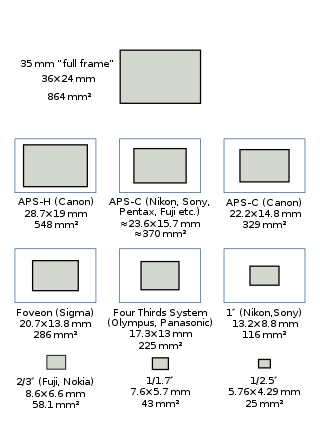
A full-frame DSLR is a digital single-lens reflex camera (DSLR) with a 35 mm image sensor format. Historically, 35 mm was one of the standard film formats, alongside larger ones, such as medium format and large format. The full-frame DSLR is in contrast to full-frame mirrorless interchangeable-lens cameras, and DSLR and mirrorless cameras with smaller sensors, much smaller than a full 35 mm frame. Many digital cameras, both compact and SLR models, use a smaller-than-35 mm frame as it is easier and cheaper to manufacture imaging sensors at a smaller size. Historically, the earliest digital SLR models, such as the Nikon NASA F4 or Kodak DCS 100, also used a smaller sensor.

The history of the single-lens reflex camera (SLR) begins with the use of a reflex mirror in a camera obscura described in 1676, but it took a long time for the design to succeed for photographic cameras. The first patent was granted in 1861, and the first cameras were produced in 1884, but while elegantly simple in concept, they were very complex in practice. One by one these complexities were overcome as optical and mechanical technology advanced, and in the 1960s the SLR camera became the preferred design for many high-end camera formats.
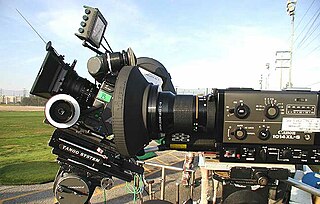
A Super 8mm camera is a motion picture camera specifically manufactured to use the Super 8mm motion picture format. Super 8mm film cameras were first manufactured in 1965 by Kodak for their newly introduced amateur film format, which replaced the Standard 8 mm film format. Manufacture continued until the rise in popularity of video cameras in the mid 1970s. In 2014 the first new Super 8mm camera in 30 years was introduced by the Danish company Logmar Camera Solutions. Most other cameras readily available are from the 1960s through the 1980s.

The Minolta A-mount camera system was a line of photographic equipment from Minolta introduced in 1985 with the world's first integrated autofocus system in the camera body with interchangeable lenses. The system used a lens mount called A-mount, with a flange focal distance 44.50 mm, one millimeter longer, 43.5 mm, than the previous SR mount from 1958. The new mount was wider, 49.7 mm vs. 44.97 mm, than the older SR-mount and had a longer flange focal distance making old manual lenses incompatible with the new system. Minolta bought the autofocus technology of Leica Correfot camera which was partly used on the a-mount autofocus technology. The mount is now used by Sony, who bought the SLR camera division from Konica Minolta, Konica and Minolta having merged a few years before.

The Pentax ME F was an amateur level, interchangeable lens, 35 mm film, single-lens reflex (SLR) camera. It was manufactured by Asahi Optical Co., Ltd. of Japan from November 1981 to 1984. The ME F was a heavily modified version of the Pentax ME-Super, and a member of the Pentax M-series family of SLRs. It was the first mass-produced SLR camera to come with an autofocus system.
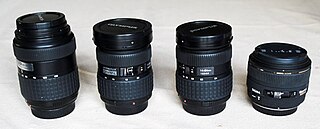
This article is about photographic lenses for single-lens reflex film cameras (SLRs) and digital single-lens reflex cameras (DSLRs). Emphasis is on modern lenses for 35 mm film SLRs and for DSLRs with sensor sizes less than or equal to 35 mm ("full-frame").

The Minolta 9000 AF is a professional Single-lens reflex autofocus camera, introduced by Minolta in August 1985. It was both Minolta's and the world's first professional autofocus SLR. It was called Minolta Maxxum 9000 in the US and Minolta α-9000 in Japan.
